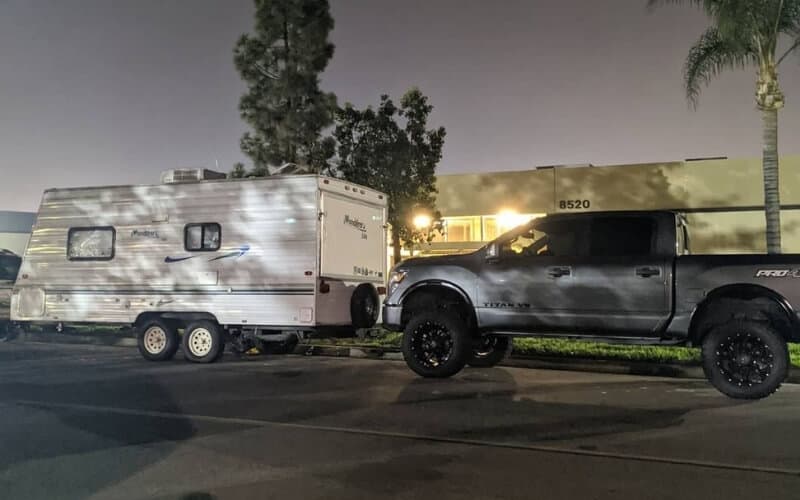
One of the biggest complaints about motorhomes and large RVs is that they are so cumbersome that they make a poor option for touring the attractions near your campsite.
Rather than having to break camp and white knuckle your way on what is often narrow roads.
Many RV adventurers answer this problem by bringing a vehicle with them from home, as it tends to be far more cost-effective than an expensive rental or hire a car.
Though no one wants to be stuck driving alone behind the rest of the family in the RV.
If you want to keep the whole family together throughout the adventure, then you might be wondering if you can tow a car behind your RV?
Thankfully, most RV motorhomes have the power to tow a car easily behind them. Though there are different methods to consider. This includes things like flat towing, using a car dolly, or loading your car onto a car hauler trailer.
Depending on the method you choose, your RV might need some additional equipment installed. It’s also worth noting that not all vehicles can be towed safely behind an RV.
To make sure you are towing your vehicle safely we’ll need to take a closer look at the nuts and bolts details.
It’s also worth noting that there’s more than one way to properly tow your car behind your RV.

IN THIS ARTICLE
Regardless of the method you choose for towing your car behind your RV, you will still need some basic tow package equipment installed.
Some RVs come with the tow package equipment and hardware installed or as part of an affordable upgrade package.
This is more common with large Class A motorhomes. If your RV doesn’t have a tow package included as standard, or you purchased one without it, you will need to seek out the services of a certified mechanic to have the tow package components professionally installed to code.
Many, but not all, RVs come with a hitch installed on the rear frame near the bumper. Though you shouldn’t just assume that your RV has one.
If you are buying online or buying a pre-owned RV you should always ask if the RV does indeed come with a hitch installed.
It’s also worth noting that there are different types of hitches to choose from. Each has its advantages and disadvantages
It is a permanent fixture installed into the bumper or your RV’s structural rear frame.
It is a far more affordable option and is relatively easy to install. Assuming you have all the necessary structural components on the rear end of your RV, you could possibly install it yourself.
The problem with a standard ball hitch is that there are different size balls for different trailers and tow vehicles.
You could run into a problem if the hitch for your chosen car towing method and another trailer, like your boat, have different ball sizes.
This means putting in the knuckle-busting work of changing the ball every time you need to tow a different trailer.
this is essentially a square channel installed into the rear structural frame of the RV.
You can switch out a heavy-duty shaft with a ball attached to it in a matter of moments. This is great for an RV that is tasked with towing a variety of trailers or equipment.
The downside of a receiver hitch assembly is the cost. If the RV doesn’t have the structural components already installed in the rear structural frame, you will have to have the receiver hitch professionally installed at a cost of $200 or more.
By law, anything you tow behind your RV must be connected to the brake and tail lights of your RV.
So that any vehicles behind you can clearly see your signal and brakes. This wiring harness also needs to include other essential components like the license plate light, and possibly an electric braking assist system.
Depending on the trailer and tow vehicle or trailer you might need a 6 or a 7 pin wiring harness.
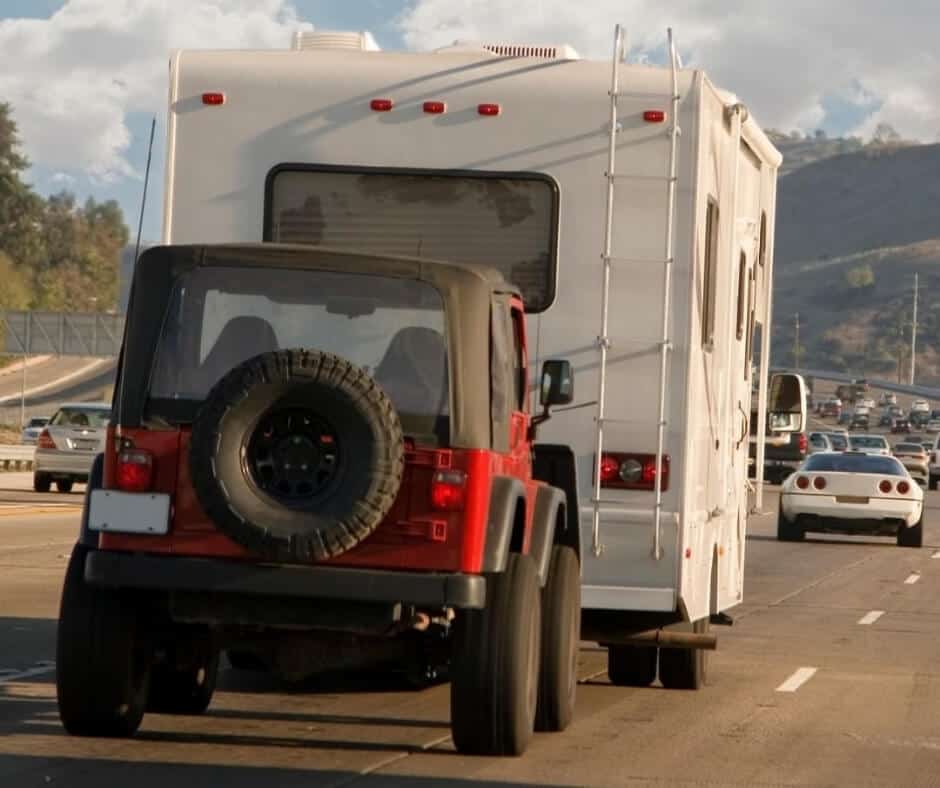
The basic truth is that not all cars do well when towed behind an RV, and certain towing methods work better for certain vehicles.
For example with the four down, flat towing method, you need a vehicle that let’s you disengage the transmission.
With a car dolly, a front wheel drive car is best, as you need to drive up on it and let the rear wheel trail behind.
When it comes to towing a vehicle on a car hauler, you need to make sure that the gross weight of the vehicle doesn’t exceed the combined weight rating of the trailer’s axles or the towing capacity of your RV.
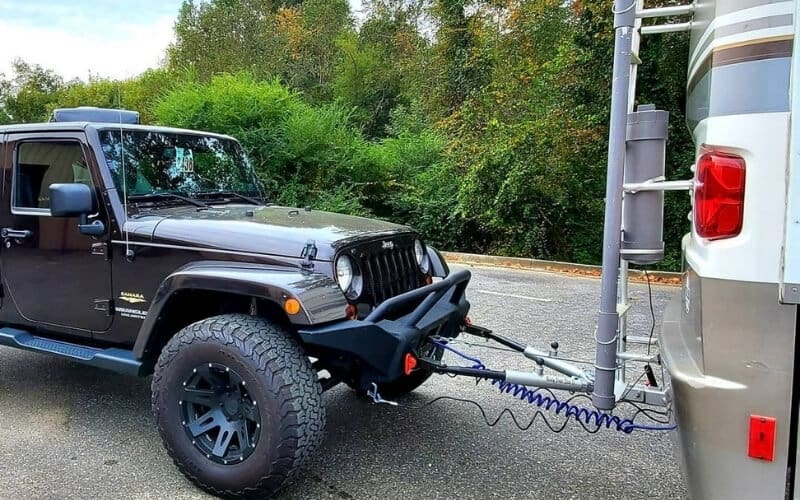
There are three popular ways to tow a car behind your RV. This includes the Four Down method, towing the vehicle with a car dolly or in a car hauler trailer.
The method that is right for you will depend on your RV as well as the vehicle itself.
The one that is best for you will depend on the vehicle you intend to tow as well as the towing capabilities of your RV.
Here’s the three ways to tow a car behind an RV:
The “Four Down” method of towing a car behind an RV is also sometimes referred to as “Flat Towing” or “Dinghy Towing.”
With this configuration, you opt out of the bulk of a trailer or a car dolly for a special tow bar. This makes it easy to tow your car behind your RV as it tracks along smoothly.
The issue here is that not all vehicles can be safely flat towed behind an RV in the four down method.
Trying to flat tow an incompatible vehicle behind an RV can cause severe damage to the car’s transmission and other critical components.
One minor drawback of the Four Down or Tow Flat method is that you can’t feasibly reverse your RV while the towed card is hitched behind it.
While it is relatively quick and easy to do this at a campsite, it could be a real hassle if you need to back up the RV while navigating on the open road.
It’s important to keep in mind that not all vehicle can be safely flat towed in the four down method behind an RV.
For starters the vehicle needs to be rear wheel drive, or the transmission can be disconnected from the drive train, or it needs to be a front wheel drive car with optional free-wheeling hubs.
Even if your vehicle meets one of these technical requirements on paper, the manufacturer might still recommend against it.
If you happen to be financing or leasing a vehicle that isn’t recommended, you could void the warranty or other contractual factors if you attempt to flat tow it.
You also need to bear in mind that flat towing a car behind an RV in the four down method involves more than simply connecting it to the rear hitch.
You need a tow bar installed as well as a base plate and special wiring harnesses.
These components typically need to be professionally installed, which needs to be factored into the overall cost.
In general, a vehicle can be flat towed behind a motorhome using the four down method if it has rear-wheel drive and a manual transmission or if it has a manual transfer case and four-wheel drive.
This allows you to put it in neutral, which effectively disconnects the transmission from the drive train.
If you aren’t sure if your vehicle’s meets these critical criteria, you can always check your owner’s manual.
Nearly all automakers make it a point to state whether or not the vehicle can be flat towed.
If they advise against it, they will likely note the preferred method such as towing the vehicle on a car dolly or a car hauler trailer.
While the selection of vehicles that qualify for flat towing is arguably limited there are still some good options to flat tow behind your RV.
They include the popular Jeep Wrangler and the Chevy Spark, just to name a few.
There are a few essential components to bear in mind when flat towing a car behind an RV using the four down method.
Some tow bars are specifically meant for flat towing a car behind an RV.
They allow the flat towed vehicle to track along smoothly without dragging or causing damage to the wheel alignment.
Some of the best options include the Roadmaster 576, the Blue Ox BX7365 Alpha, Nighthawk Roadmaster 676, the Demco Excali-Bar II LB, and the NSA RV Products Tow Bar.
This is an essential piece of hardware that needs to be professionally installed onto the car or other vehicle being flat towed behind an RV in the Four Down method.
The wiring harness on the RV needs to be compatible with the connection for the car being towed behind.
This usually requires professional installation on the car to make sure all the signals and brake lights work in unison with the RV.
these heavy-duty cables or chains are a critical component of any safe towing operation.
They are sort of a last line of defense should something fail in the hitch connection between the RV and the car being towed behind it.
Without them, a rare, accidental disconnection could turn into a major disaster while you’re driving down the road.
one of the nice things about flat towing a car behind an RV is the ability to use the vehicle’s existing braking system.
Depending on your RV’s wiring harness and the connection to the car, an electronic braking system might be run alongside the rest of the wiring harness.
Then when you step on the RV’s brakes it also engages the towed car’s brakes. Not only does this reduce wear and tear on the RV’s brakes, but it also buffers the towed vehicle from being jarred by frequent stops and starts.
Though an electronic braking assistance system does cost a pretty penny, and unless you are already mechanically adept, it’s not the sort of thing you should try to do yourself.
Though the professional mechanic who installs the base plate can usually install the electronic braking system at the same time, for around $1,500 to $2,500.
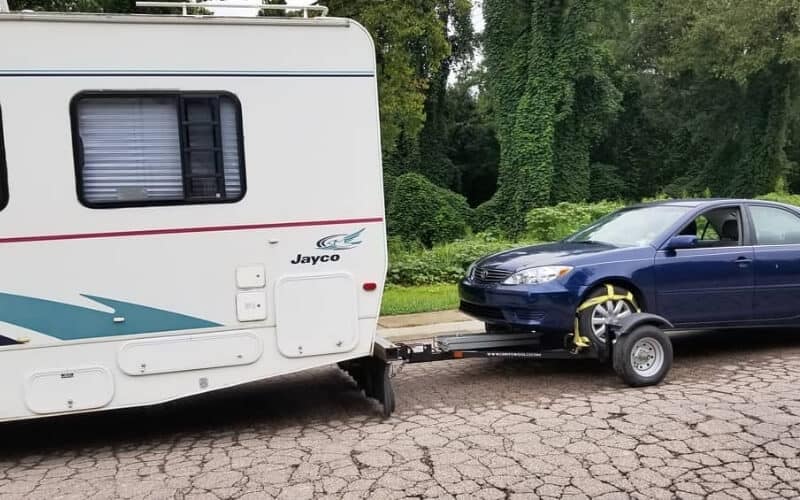
A car dolly or tow dolly is essentially a special type of trailer that is specifically designed to make it easy to tow a car behind a full-size pickup truck or RV.
It only has two wheels and a tongue. Ideally, a car dolly works best with a front-wheel-drive car.
You simply drive up to it to the point that the front wheels are on the load plate and the rear wheels of the car are still touching the road surface.
The front wheels are then firmly secured to the tow dolly. You then tow the vehicle behind your RV like you would a small trailer.
Just like flat towing a car, you need some basic equipment to safely and legally use a tow dolly behind your RV.
Just bear in mind that in most states a car dolly is treated the same as a trailer. This means you will need to maintain up to date license tabs and all other DOT regulations.
These are critical for securing the vehicle’s tires and structural frame to the tow dolly.
While they are relatively simple to operate, it does help to practice securing and releasing the car dolly’s ratchet straps, before you head out on your RV adventure.
just like towing anything, the safety chains or cables are the last line of defense against a rare, accidental disconnect between the tongue of the car dolly and the hitch of the RV tow vehicle.
A lot of experienced tow dolly operators will advocate crossing the safety chains in an X to reduce the risk of them accidentally getting knocked loose when driving over bumpy roads.
considered by most to be optional, an electronic braking assist system can be installed onto the car and run alongside the standard wiring loom that runs the indicator lights.
This engages the vehicle’s rear brakes when being towed to reduce wear and tear on the RV’s hitch or rear frame.
Most modern car dollies have some type of folding ramp system engineered into them.
Though car dollies do tend to have rather long lifespans. An older model that you buy second hand, might not have ramps.
Though you can buy an aftermarket set like you would use to change your car’s oil for relatively cheap.
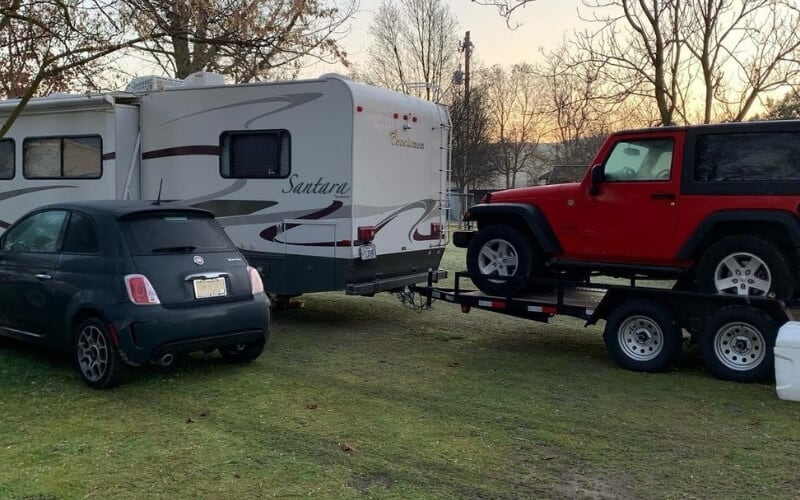
Car haulers are essentially heavy-duty trailers that are designed to have the width, height, and other structural considerations for towing a car.
An enclosed car hauler can also be repurposed as a tool and equipment trailers for construction contractors.
If you work in the construction or remodeling industry, they can have dual value.
Though an enclosed car hauler does tend to weigh more and has worse aerodynamics compared to an open flatbed car hauler.
Most of the best car haulers for towing behind an RV have dual axles. Each has its own weight rating which you need to double-check against the weight of the vehicle you intend to tow behind your RV.
Unless you are bringing a lightweight sedan or compact car, you want to look for a car hauler that is rated to carry at least 3,000 pounds per axle.
With a car hauler trailer, you basically need the same wiring harness and safety chains that you do with any other type of standard trailers. Though there are a few special considerations to keep in mind.
Some car haulers come with some type of built-in ramp system. Though some older models do not.
If you are buying a pre-owned car hauler without ramps, make sure that the ramps your source is the right height for loading and unloading a vehicle directly onto a flatbed.
You also need to double-check that their weight rating is sufficient for the car you will be towing behind your RV.
Most modern-day car haulers come with some type of braking system. Though there is no one standard for all of them.
Surge brakes are a special type of trailer brake that doesn’t need any sort of special wiring or brake controls.
They use a hydraulic cylinder that applies pressure to the braking system. This makes them inexpensive and easy to use.
Though they are not as effective as electronic braking systems, which are wired to the braking system of the RV and stop in tandem.
Many trailers come with hidden ramps and one of two different braking systems. Surge brakes do not require a separate brake controller for the RV, but electric brakes do.
In the case of a vehicle on a car dolly or on a car hauler trailer there is very little effect on the vehicle itself.
Of course, this is assuming that everything is done correctly. Improper strapping, loose connections or loading the vehicle abusively can indeed cause a significant amount of damage to a car on a dolly or car hauler.
In the case of a car being flat towed behind an RV using the four down method, there are some finer points that come into play.
It’s important to note that in an automatic transmissions or a pump-dependent manual transmission, the output shaft is only being lubricated when the vehicle’s engine is running.
This means that the vehicle can suffer severe transmission damage if it’s being towed with the drive wheels rolling along the highway.
This is a major reason why some vehicle manufacturers don’t recommend flat towing.
It’s also worth bearing in mind that there are some other mechanical concerns when it comes to towing a car behind an RV.
Things like tear wear can add up if you are frequently towing a car behind your RV.
Over time the excess wear on the rear tires of a car dolly towed vehicle can need rotation to allow for a smooth ride.
At the same time, electronic braking assist systems will also go a long way toward preventing the wear and tear caused by frequent stops and starts.
This is a stronger factor for flat towed cars and car hauler trailers that only have surge brakes.
This depends on the towing method. In the case of a car haulers, the trailer is the thing that’s putting on the miles.
In the case of a car dolly car, the odometer will only turn if the vehicle is rear wheel drive.
With a flat towed vehicle using the four down method the transmission needs to be disengaged from the drive train, which will prevent the odometer from moving.
Of course, this is all from the perspective of reselling to trading in the car and the odometer reading the dealer or private seller look at.
When it comes to the overall life of the vehicle, you will still experience tire wear on a flat towed or car dolly method.
Electronic braking systems will also add to the overall pad wear on the brakes and rotors.
The electric motors inside an electric car make it a very bad idea to flat tow or tow it on a car dolly. Though when properly secured on a car hauler, you could very easily tow an electric car behind your RV.
With most automatic transmissions the lubricating pump only runs when the engine is on.
So, towing automatic car in neutral will inevitably cause significant wear and tear on the automatic transmission.
If you want to tow a car with an automatic transmission behind your RV, you will need to put it on a car dolly or load it onto a car hauler trailer.
The best way to tow a car behind your RV can vary depending on the vehicle, the RV, and your overall budget.
If you have a vehicle that’s capable of being towed flat in the four down method, and you have the budget to have all the wiring and other components installed, then it’s a great way to spare wear and tear on your RV as well as the car being towed.
If you are running on a somewhat limited budget and you have a front-wheel-drive vehicle, then a car dolly might be the best way to tow a car behind your RV.
If you have a little more budget to play with and you have a heavier car or SUV that you want to tow behind your RV, then a car hauler is probably the better option.
You get more space and payload capacity. While you are at it, you might want to also splurge for the electronic braking assist.
Aaron Richardson is an expert RVer and the co-founder of RVing Know How. Aaron, along with his wife Evelyn, has been living and traveling in their Keystone Fuzion RV since 2017. Their adventures span across the country and beyond, including memorable RVing experiences in Mexico. Aaron's passion for the outdoors and RVing shines through in his writings, where he shares a blend of travel stories, practical tips, and insights to enhance the RV lifestyle.